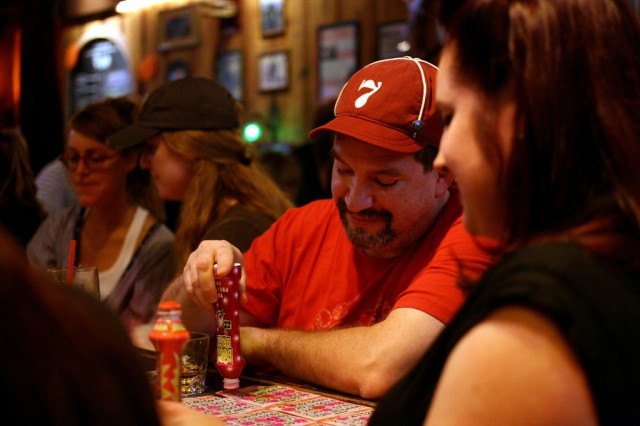
Written by Thomas Rizza
It’s an uncharacteristically warm Monday in late September at SF State. Dr. Selim Sayers, the newest addition to the Middle East Studies Program, plugs in his laptop to the projector and gets his materials in order. He produces a plastic bag from his case and sets it on the desk. With a smile, Sayers greets the class only to hear tired murmurs from the students. He then reaches into the plastic bag and pulls out two peculiar metal tubes. “Here,” he laughs as he passes the used tear gas canisters to a student. “Some souvenirs from Turkey.”
Turk 260’s official course name is Turkish Culture and Identities, but it’s really a class about revolution. Dr. Sayers teaches about Ottoman history and literature, but he also is using it as a vehicle to teach about his experiences taking part in the Gezi Park protests in Istanbul over this past summer.
With only sixteen students enrolled, it’s a small class tucked away in a corner on the third floor of the Humanities building. The room is stuffy and looks like it was a janitor’s closet before converting to a classroom. But like the Turkish uprising, every great idea starts small.
The Gezi Park protests began on May 28, 2013 and took place in Taksim Square in Istanbul. The protests were a response to police brutality toward environmentalist activists engaging in a sit-in against urban development in Gezi Park, which would have replaced the park with a shopping mall. After that, thousands of people occupied the Taksim Square and rioted in cities across Turkey in solidarity with the environmentalists and against the authoritarian actions of their government. The protest is ongoing today.
“We were in it 24/7,” recalls Dr. Sayers. “When we got news about a police crackdown or something, we would leave our room and get on the street and go where it was. A few nights in the square a guy gave piano recitals. People and clashes were happening on the street. We would be protesting on the streets.”
Dr. Sayers was born in England thirty five years ago, his mother Turkish, his father British. After his parents divorced at age three, Sayers spent his childhood with his grandparents in Istanbul where he attended primary school. He developed a deep connection with the country that continued into his collegiate career, which included a Masters in Turkish Literature. From 2000 to 2002 he worked as a producer for CNN Turk, a subsidiary of the international news channel. Sayers also wrote a weekly column for the newspaper Sabah and worked as a radio DJ during his time in the country. Much of his family still lives in Turkey, which further strengthened his emotional bond with the country.
Dr. Sayers received an offer from SF State, coincidentally, while he was attending a protest in Zuccotti Park in New York City, the home of the Occupy movement. The protest was in solidarity with the events that had begun in Gezi Park, just days before he stepped on a plane to Turkey. Prof. Burcu Ellis, a member of the board that hired Dr. Sayers, was excited to bring him into the Middle East Islamic Studies faculty.
“He’s dynamic and really hit the ground running,” says Prof. Ellis. “He has a very good focus on social issues and a deep perspective, with his background in media and academic studies. He’s not just a language teacher, he’s the full package.”
Dr. Sayers’ involvement in the events is somewhat a coincidence. He was originally planning to take his annual trip to Turkey in mid-June, but the death of his grandmother caused him to leave sooner. He landed in Turkey on June 3, just five days after the start of the protest. After attending the funeral, he met up with his wife, Evrim Emir-Sayers, in Istanbul where she was working as a fellow at the Netherlands Institute in Turkey. Their office and accommodations are located on Istiklal Avenue, the street that leads to Taksim Square and Gezi Park.
The location exposed them to the vibrant diversity of the protests; the joy and festive nature of the masses of people as they sang and danced, read and distributed literature, performed art in the square, suddenly transitioning to the fear and chaos brought on by police action and resistance.
In one of his more harrowing memories, Dr. Sayers describes an evening where police cleared thousands of people from the park. The police were intent on getting people out of the Gezi Park, not the surrounding Taksim square. What ensued was mass confusion as police fired tear gas, sound grenades, and rubber bullets into the park.
Protesters were running through thick clouds of smoke and dodging other people and trees trying to escape the siege. Eventually Dr. Sayers, his wife, and many other protesters fled to a hotel across the street from the park. The staff let the protestors in to stay the night while the police barricaded off the doors until the park was cleared.
“It’s a strange feeling,” says Dr. Sayers. “When you’re in the middle of it and you have some conviction for the issue at hand. I need to be out here, I need to be protesting. This is something that concerns me and my family. You’re just going with the flow because it’s happening all around you.”
There was no time to feel fear. In retrospect, the events left a mark on him psychologically that has not gone away. He tries to avoid large crowds, because they tend to make him anxious. When he sees smoke, he immediately is reminded of being tear gassed on multiple occasions.
“I’ve never heard a gun being fired,” he continues with a distant look, “and suddenly here I was running away from people shooting at me or trying to avoid being detected by people trying to arrest me and take me to a police station and do God knows what to me. After it ended, I looked back, and then I was afraid because anything could have happened.”
Dr. Sayers left Turkey on July 6 to settle in San Francisco and get his lesson plan in order for his first semester at SF State. Turkish Cultures and Identities didn’t start as a study on the parallels of Ottoman history and the factors involved in the Turkish Rising. The more
Dr. Sayers thought about his involvement in the protests, he felt more compelled to tackle the subject.
“It would have been easy, maybe prudent, if I made Turkish Cultures and Identities about something like literature that I know more about,” states Dr. Sayers. “As I told my students, I’m not an expert on this kind of Turkish political history. But I felt this is a great platform for exploring this [Gezi Park]. I couldn’t pass up the chance. I was an eyewitness. I was in the middle of all this. I do have the historical background. We can do this.”
According to an article published by the New York Times, the Turkish government enforced a media black out strategy that pressured media outlets to sack journalists for reporting on the events in Gezi Park. As of July 23, seventy-two journalists had lost their jobs. The government’s harsh treatment of journalists and the flow of information is one of the main issues that pushed Dr. Sayers to educate people about the protests.
“The media is in no way shape or form independent,” explains Dr. Sayers. “Most, if not all, of it is owned by corporate interest groups that use it as a bargaining chip with government to get their messages out. The private media cannot be trusted and the public media is controlled by the government.”
One of the most egregious examples of the media blackout was when Dr. Sayers former employer, CNN Turk, chose to show a documentary about penguins when the police first took action in the park. The penguin was embraced by the Turkish community as a symbol of the revolution against media suppression. In the face of the crackdown, protesters turned to social media outlets such as Facebook and Twitter in order to communicate, as well as share information and images.
Some of Dr. Sayers’ friends from his days at CNN Turk expressed their dissatisfaction with their employers on Facebook. “A cameraman friend made the point that at CNN Turk, we have sent reporters to civil wars and uprising elsewhere in the world,” says Dr. Sayers. “We’ve never been shy about that. It’s sad when the biggest news story of our lives is happening outside our doors and we can’t go cover it.”
The Turkish Prime Minister, Tayyip Erdoğan, famously expressed his distaste for Twitter amidst the riots. “Now we have a menace that is called Twitter,” said Erdoğan. “The best example of lies can be found there. To me, social media is the worst menace to society.”
Dr. Sayers goal is to teach students how to decipher media and formulate an informed opinion about a topic, as much as learning the Turkish history in relation to current events.
“How do you judge the information that you get from a media outlet and how do you weigh that against the history in order to put the pieces of the puzzle together?” asks Dr. Sayers. “There is a big difference between knowing about what events happened right now and appreciating how they came about through history. Take that historical knowledge to assess the news you’re getting right now to know what to trust.”
So far, Dr. Sayers message seems to be leaving an impression on his students. Raphael Sirvent is a sophomore majoring in international relations. Before enrolling in this class, he had no knowledge of Turkey besides the fact that they have some great soccer teams. “I heard about the class when [Dr. Sayers] was advertising it in another class I was trying to crash.” recalls Sirvent. “I wanted to educate myself about Turkey, and he made the class sound really interesting. What’s been super cool is that we’re getting real insider-knowledge that you can’t find anywhere else.”
The class is also a valuable resource for senior Gozde Gultoprak, who was born in Izmir, Turkey and grew up there until her family moved to America when she was ten years old. Many of Gultoprak’s family members and friends still live in Turkey where they continue to be apart of the protests today.
“I wanted to take this class to learn more about the Ottoman Empire, and also hear different perspective from the professor about the Gezi Park protests,” explains Gultoprak. “I know a lot about Gezi Park protests because I read the Turkish News from many different sources every day, but of course the class taught me many more things in addition to what I know.”
Dr. Sayers isn’t quite sure whether to revisit his experiences in later semesters. The situation in Turkey is volatile. By the time he is slated to teach Turkish Cultures and Identities in Fall 2014, presidential and local elections in the country will have taken place.
Will the events from this past semester have a direct impact on these elections? Will the results spawn new protests and bring about change? Revolutions move fast, but we will just to have wait and see.




